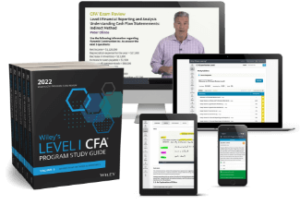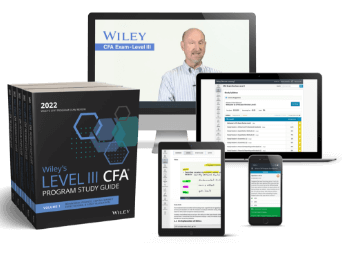CFA Equity Investments

CFA Equity Investments Quick Facts
- There are five types of execution orders: Hidden, Limit, All-or-nothing, Market, and Iceberg.
- There are four types of security index weighting models: Price, Market-cap, Equal, and Fundamental.
- The Gordon growth model assumes dividends will grow forever at a constant rate.
- There are three types of equity valuation models: present value, multiplier, and asset-based valuation.
Introducing CFA Level I Equity Investments
Equity Investments CFA Level I Practice Questions
How to Approach Market Organization and Structure
Traders will receive a margin call when the equity price drops below the maintenance margin requirement.
There are also execution orders. A market order occurs when an order is executed immediately at the best price. In a limit order, buyers set their maximum price and issuers set their minimum price. The order is only executed if those respective prices are hit. Limit orders may not always be executed if the markets are moving quickly or if there is not enough liquidity.
All-or-nothing orders occur only when the entire quantity can be traded. Large orders that are only known by the brokers or exchangers that are executing them are referred to as hidden orders. An iceberg order is when a small fraction of a larger hidden order is executed to test the market liquidity before the entire hidden order is executed.
Market Organization and Structure Question Example
A well-functioning securities market least likely has:
- Informational efficiency
- Liquidity
- Accurately priced securities
Answer C. This is not one of the features of a well-functioning securities market.
How to Approach Security Market Indexes
The first is price weighting. The weight of the security is determined by dividing its price by the sum of total prices in the index.
The second is equal weighting. For equal weighting, each security is given equal weight at inception.
The third is market-cap weighting. For this, the weight of each security is determined by dividing its market cap by the total market cap of the index.
The final weight level is fundamental weighting. In this weighting model, the value of the securities is contingent upon different measures like book value, revenues, or cash flow. This means the securities are biased towards the stock price, creating a value tilt.
Security Market Indexes Question Example
wEi=1/N
The formula above represents which security market index weighting level?
- Price weighting
- Fundamental weighting
- Equal weighting
Answer C.
How to Approach CFA Equity Valuation
For a dividend to be paid, there must be a declaration date. Then there is an ex-dividend date. Approximately two days later, there is a holder-of-record date. After the holder-of-record date, the payment date occurs. It’s worth noting that holders of preferred shares receive dividend payments before common shareholders.
The dividend discount model determines the intrinsic value by adding the present value of future dividends to the present value of the terminal value. While the Gordon growth model assumes dividends will grow forever at a constant rate.
Pricing multiples include the price to earnings ratio, price to book ratio, price to sales ratio, price to cash flow ratio, and enterprise value.
CFA Equity Valuation Question Example
Which of the following formulas is not a price multiple?
- Price per share/book value per share
- Price per share/sales per share
- Market value of debts + market price of equity + market value of preferred shares + cash and short-term investments
Answer C.
Introducing Equity CFA Level II
Wiley offers specific studying materials to help you excel from Level I to Level II, including professional online mentoring, Mock Exams, and a dashboard with performance metrics to help keep you on track.
Equity CFA Level II Practice Questions
How to Approach Equity Valuation: Applications and Processes
Equity Valuation: Applications and Processes Question Example
The value of an asset between a willing buyer and a willing issuer, when neither of whom is under compulsion to buy or sell is called:
- Investment value
- Fair market value
- Intrinsic value
Answer B.
How to Approach Industry and Company Analysis
Industry and Company Analysis Question Example
Which of the following is not one of Michael Porter’s five factors?
- Bargaining power of customers
- Threat of substitute products
- Taxes and regulations
Answer C.
How to Approach Discounted Dividend Valuation
Discounted Dividend Valuation Question Example
There are three phases to a business life cycle; growth, transition, and mature. In which phase would the Gordon growth model be most appropriate?
- Growth
- Transition
- Mature
Answer C.
Introducing Equity CFA Level III
Candidates all over the world rely on Wiley to help them pass Level III.
Equity CFA Level III Practice Questions
How to Approach an Equity Investment Vignette
In order to assess the funds, Macdonald reviews their performance relative to the index. Details of their performances over the past 12 months are shown in Exhibit 1 Enhanced Equity Index Fund Performance.
Exhibit 1: Enhanced Equity Fund Performance
Month |
DAX TR |
Fund A |
Fund B |
|---|---|---|---|
| 1 | 0.13% | 0.16% | 0.25% |
| 2 | 1.65% | 1.48% | 1.57% |
| 3 | -0.98% | -0.87% | -1.08% |
| 4 | -1.13% | -1.09% | -0.89% |
| 5 | -1.86% | -2.32% | -1.76% |
| 6 | 2.87% | 2.89% | 2.68% |
| 7 | 0.42% | 0.65% | 0.36% |
| 8 | 0.19% | -0.08% | 0.32% |
| 9 | 1.62% | 1.69% | 1.37% |
| 10 | 2.32% | 1.98% | 2.00% |
| 11 | -1.64% | -1.48% | -1.59% |
| 12 | 0.67% | 0.75% | 0.33% |
Equity Investment Constructed Response (Essay) Question Example
Compare the performance of Fund A and Fund B by calculating their respective tracking errors.
Equity Investment Item Set Question Example
Enter given or calculated values and percentages in the following spreadsheet. Enter amounts to two decimal places. If no entry is required, enter a zero (0).
Line Item |
Fund A |
Fund B |
|---|---|---|
| Mean monthly excess return (%pm) | ||
| Tracking error (% pm) | ||
| Annualized tracking error |
Answer:
Line Item |
Fund A |
Fund B |
|---|---|---|
| Mean monthly excess return (%pm) | -0.042% | -0.058% |
| Tracking error (% pm) | 0.220% | 0.200% |
| Annualized tracking error | 0.763% | 0.691% |
Fund A
Month |
Excess Return (A) |
Squared Excess Return |
|---|---|---|
| 1 | 0.03% | 0.00001% |
| 2 | -0.17% | 0.00029% |
| 3 | 0.11% | 0.00012% |
| 4 | 0.04% | 0.00002% |
| 5 | -0.46% | 0.00212% |
| 6 | 0.02% | 0.00000% |
| 7 | 0.23% | 0.00053% |
| 8 | -0.27% | 0.00073% |
| 9 | 0.07% | 0.00005% |
| 10 | -0.34% | 0.00116% |
| 11 | 0.16% | 0.00026% |
| 12 | 0.08% | 0.00006% |
| Sum | -0.500% | 0.0053% |
| Mean | -0.042% |
Standard deviation of monthly excess return=(0.0053%/11)1/2=0.220%
This is the monthly tracking error of Fund A.
To annualize, multiply the monthly TE by the square root of 12:TEA=0.220×121/2=0.763%
Fund B
Month |
Excess Return (B) |
Squared Excess Return |
|---|---|---|
| 1 | 0.12% | 0.00014% |
| 2 | -0.08% | 0.00006% |
| 3 | -0.10% | 0.00010% |
| 4 | 0.24% | 0.00058% |
| 5 | 0.10% | 0.00010% |
| 6 | -0.19% | 0.00036% |
| 7 | -0.06% | 0.00004% |
| 8 | 0.13% | 0.00017% |
| 9 | -0.25% | 0.00062% |
| 10 | -0.32% | 0.00102% |
| 11 | 0.05% | 0.00003% |
| 12 | -0.34% | 0.00116% |
| Sum | -0.700% | 0.0044% |
| Mean | -0.058% |
Standard deviation of monthly excess return=(0.0044%/11)1/2=0.200%
This is the monthly tracking error of Fund B.
To annualize, multiply the monthly TE by the square root of 12:TEB=0.220×121/2=0.691%
Note: The above calculation of tracking error is the standard deviation between the fund and benchmark returns, that is, σRP–RB. Tracking error is also often calculated as the standard deviation of the excess returns (i.e., ER = RP – RB), which will usually give a slightly different result; that is, σER.
CFA Equity Investments Cross-Level Study Tips
Use CFA Level I Equity Investments to Get a Strong Grounding in This Topic
Building a strong foundation from Level I will help you understand the true logic of Equity Investments instead of just memorizing formulas.
Also Practice Quantitative Equity Questions
Although most questions will focus on qualitative elements, it is important you understand how to calculate formulas, like free cash flows and the rate of return.
Wiley’s study materials can help you cover this topic and other aspects of the Equity Investments components.
View Wiley’s CFA Program Review Courses
Understand the Practical Application of Equity Valuation Models
There are three types of equity valuation models that you must be familiar with: present value models, multiplier models, and asset-based valuation.
These are vital methods you will need to evaluate modern Equity Investments, both on the CFA exam and in your future career as a Chartered Financial Analyst.
Sign Up for a Study Program With Excellent Success Rates
When investing in a study platform, review all of the resources available to you. Wiley offers an array of study sessions with experienced instructors, online mentoring, and more. With a 90% pass rate, Wiley will help you pass the CFA exam the first time.
CFA Equity Investments – Frequently Asked Questions (FAQs)
Here are answers to some frequently asked questions about CFA Equity Investments.
- CFA Equity Investments teach you about the characteristics of a sound financial system, market efficiencies, behavioral finances, and how to value equity.
- Yes, and it can help you move up the career ladder.
- Compared to derivatives, yes! With preparation, you can achieve success.
- No; however, to advance in the field, a CFA is beneficial.
- The three types of equity securities are common stocks, preferred stocks, and convertible bonds.
Related Articles
We use cookies to learn how you use our website and to ensure that you have the best possible experience.
By continuing to use our website, you are accepting the use of cookies.
Learn More





